< Rain | List of articles related to FIPP | Brains >
While playing the video press the "HQ" button (in the right bottom corner of the YouTube player) in order to improve playback quality
Fodormik's Integrated Paradigm for Psychology (FIPP)
Miklos Fodor developed a model based on three basic concepts (later highlighted in bold) that can describe human behavior in different fields of life e.g. problem solving, love, religion, sex, co-operation. The essence of the model is that it reinterprets the relationship of the Self and Environment, which to date has been considered as a static relationship. Thus, the model distinguishes
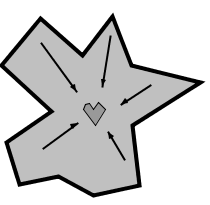 Self-narrowing: when the Self perceives the Environment as bigger than itself e.g. in anxiety, fear, making efforts, close attention.
Self-narrowing: when the Self perceives the Environment as bigger than itself e.g. in anxiety, fear, making efforts, close attention.
 Self-expanding: when the Self expands into the Environment and perceives it as a part of itself e.g. love, happiness, aha experience, orgasm.
Self-expanding: when the Self expands into the Environment and perceives it as a part of itself e.g. love, happiness, aha experience, orgasm.
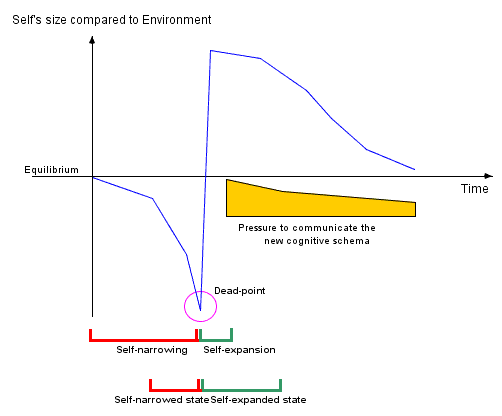
The change of the two states can be described with a general pattern, in which the turning point is the emergence of new cognitive schemata, being mental constructions organized on different levels, representing the outside world e.g. concepts, theories, shapes, categories.
The emergence of a new cognitive schema results in a need to communicate, which prompts the Self to associate the new schema with others. The Self-expanding is complete only when such communication occurs.
Example: Problem solving
- Self-narrowing: as we learn more about a problem, finding a solution to it seems to be increasingly hopeless.
- Self-expanding: when the person is about to give up, a new cognitive schema establishes itself, which in turn provides a solution to the problem.
- Communicational pressure: regardless of obtaining a solution to the problem, the person does not experience complete Self-expanding until he can share it with others.
A detailed description of the model and of the basic concepts, with further examples, is provided here.
One virtue of this new model is that it integrates our knowledge of human behavior yet does not contradict psychology’s main discoveries. In addition, it harmonizes with statements of world religions and common sense.
On this page... (hide)
1. Introduction to the phenomena of Enlightenment
Spiritual Enlightenment is defined as a religious concept uniting with the world by understanding the principal connections and driving forces of the universe. Although the concept itself primarily originates in Buddhism, similar states of mind are described in other religions and cultures. For example, in Christianity, “saint” is the word that describes someone so close to God, or to the universe, that makes him special. In certain professions there are comparable concepts: those who attain the highest results or abilities in their field are called guru or grand master, a person who is able to answer all questions related to his field.
Throughout history, many people have attained this status, and were treated with great respect in their cultures. According to their own accounts, enlightenment is accompanied by eternal, constant happiness and calmness, while earthly, everyday matters lose their apparent importance.
The similarity between enlightment and maximum Self-expansion which comes after the establishment of a top cognitive schema that integrates all knowledge available to the person, is quite noticeable. We will now examine why these two states are the same.
2. What is enlightenment according to the concept of FIPP?
2.1 The cognitive schemata of enlightened people
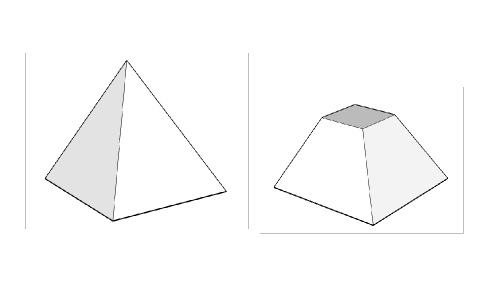
Pyramid and frustum of pyramid
To understand enlightenment from the viewpoint of FIPP, we have to keep the hierarchic construction of cognitive schemata in view. In the following, imagine the cognitive schemata’s hierarchy as a pyramid, where each building block of the pyramid is an individual cognitive schemata. The top of the pyramid indicates the cognitive schema, the so-called top-schema which integrates everything. Not all pyramids are complete: some frustums of pyramids indicate all of the people who did not succeed in integrating their knowledge in a connected system throughout their lives; namely, they did not achieve enlightenment.
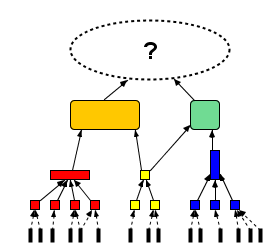
In the pyramids of cognitive schemata, of interest is that every upper-level cognitive schema contains the lower-level cognitive schemata in an integrated way. In conclusion, the top cognitive schema has to contain the complete cognitive schema hierarchy i.e. everything that the person knows. (This is similar to the CEO of a company who is aware of all the information known collectively by his employees.)
Ignoring for the moment the concept of cognitive schemata, how can we erect a pyramid to be the most stable and the highest in the most efficient way?
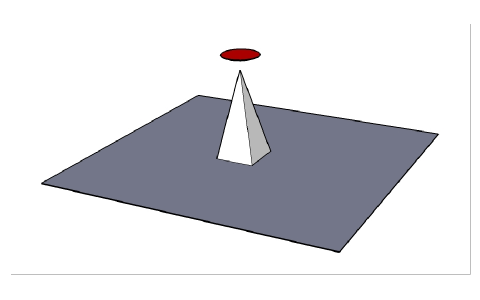
A pyramid built on a small base and the enlightenment's level (with red)
- One possible solution is a tall pyramid having a small base. This would mean reducing our level of aspiration, as a pyramid with a small base requires less material and construction time. However, it is less stable, and precludes the possibility of building a high structure. This pyramid with a small base can be seen in tandem with the enlightenment of those people who live in an environment poorer in information e.g. on the top of a hill or in a hidden little village or in a monastery. Achieving enlightenment is easier for someone who has been partially isolated all his life from the outside world, since he has less cognitive schemata e.g. he has not heard of or seen drug dealers and gang warfare. Therefore, it is easier to integrate those few schemata.
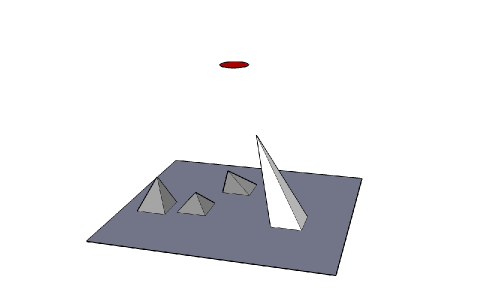
Asymmetrically (thus unstable), but high pyramid
- Another possible strategy is to build a pyramid asymmetrically. This reminds us of the strategies of specialists in a narrow subject area with no other interests who, although they may have many cognitive schemata, develop in only one field, albeit one in which they achieve outstanding results. Nevertheless, this raises the question whether the pyramid collapses if it is not properly buttressed. Can such a person cope with impulses different from those of his profession? An excellent mathematician may find social relationships extremely difficult to comprehend or cope with. An altruistic social worker may miss out on certain possessions or pursuits as he does not care about money.
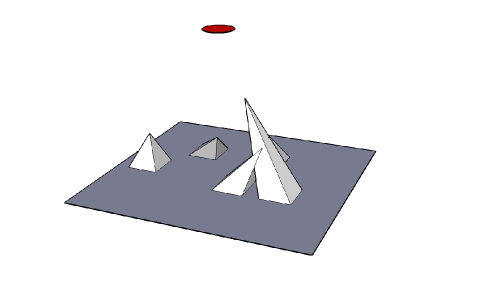
An asymmetric pyramid supported by other pyramids making it able to grow
- The most reliable strategy may be not to build a perfect pyramid, but to shore up and surround our main pyramid with many sub-pyramids. This is the approach adopted by different school systems to promote the improvement of general knowledge. Apart from creating noticeable Self-expansion, general knowledge offers a chance to understand in which field the cognitive schemata establishes quickest, and so identify his particular talent. Another effect of general knowledge is that it forms a bridge with other lower-level cognitive schemata and this bridge supports the main interest, enabling it to development of the Self to a much higher level.
2.2 Self and Environment of Enlighten people
Unification with the universe is a major phenomenon within Enlightenment. Those who reach this state feel themselves as part of the universe, and are unable to divide themselves from the outside world. They experience the world without mental pre-processing, so no new schemata are born, as all stimuli reach those schemata they are intended to.
This phenomenon can be described using the FIPP’s terms, as the boundary between Self and Environment has disappeared. As all schemata that can be have been born, there are no more conflicts within the perceived entities, and there is no need for restructuring anything within these cognitive schemata. Everything has been completed.
Emotionally, this leads to a calm that can be perceived as depression. The calmness/depression arises in that Self-narrowing and Self-extension have no place in the future. The Self is unified with the Environment, so there is no more fear from the possibility that the Environment will destroy the Self, as the two entities no longer differ. Lack of fear and anxiety is also a typical description of an enlighten person’s state, and can be explained by the irrelevance of Self-narrowing as well. Another observation on the enlighten state is that it is indescribable, in that as a top-level schema, it is not necessarily a verbal construct; it can not be translated into words, as words depict far lower-level schemata. So as it can not be translated into schemata that are available for ordinary people, it also can not be communicated.
3. How does enlightenment happen according to the FIPP?
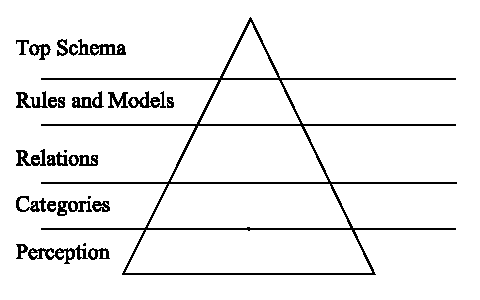
Different levels of complexity within the pyramid
On the lowest level of the pyramid of cognitive schemata, the most basic elements of stimuli from the outside world can be found; colors, shapes etc. It is upon these that the categories and concepts that represent objects and people are built. Upon these categories we find the similarities that describe connections between objects and people, which become increasingly complex as we proceed to higher levels. Attaining a higher-level cognitive schema happens through induction; downward conclusions take place through deduction. Induction is the process where the Self finds a connection between two or more discrete cognitive schemata, and establishes a new, higher-level, cognitive schema. The process of deduction is where a higher-level schema combines with another schema yet a new – but lower-level – schema emerges. An example of induction: a basketball is spherical, a table-tennis ball is spherical, a football is spherical. The conclusion: that all balls are spherical (of course you can always find exceptions like the rugby ball). An example of deduction: what shape can a baseball have? Since it is a ball it must be spherical. In this case the baseball as another schema connects with the higher-level schema (ball).
The stimuli and concepts that reach people form groups due to their nature: visual cognitive schemata, such as colors, are different from musical schemata, for instance a tune. These groups can be found at different places in the base of the big pyramid, and they themselves form smaller pyramids. For example, Mozart had an extremely high musical pyramid with a wide base, while Einstein, although also having a high musical pyramid – he played the violin well – had a higher and wider physics pyramid. This did not mean that either of them had to have a large pyramid connected to, for example, swimming.
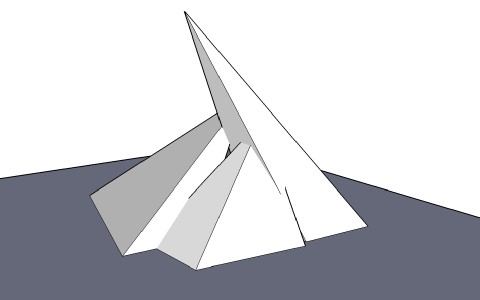
If its neighbors are also high, a pyramid can grow really high
Schemata are interesting in that these pyramids can become mixed after awhile. A mathematician might find mathematical connections – rhythms, beats per minute, wavelengths, harmonic theory, note ratio et al – in music. Or the manner in which the results of biology influence our vision of society, as happened with the adoption of Darwinism.
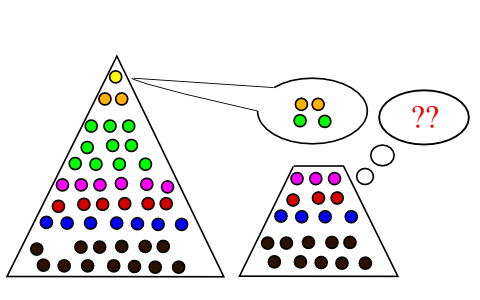
It is hard to understand a guru
We have previously mentioned one characteristic of enlightenment…that in the enlighten person’s mind, everything becomes connected with everything else and a simple pattern, the highest level cognitive schema, explains everything that he knows. Since the top cognitive schema is built on cognitive schemata immediately below it, which are equally unknown to – or identified differently by – other people, he is not capable of communicating his top-level cognitive schema, as in the minds of others there are no adequate/relevant cognitive schemata that they can build upon. Moreover, it is not at all sure that this top-level cognitive schema can be expressed in words. For example, it is possible that a top-level “general” tune explained everything about life to Mozart, and tunes can not be translated into words). It is said “it’s easy if you know how” of people who find “it” easy, as he has a higher-level cognitive schema, as well as all those beneath it, and so everything is self-evident to him.
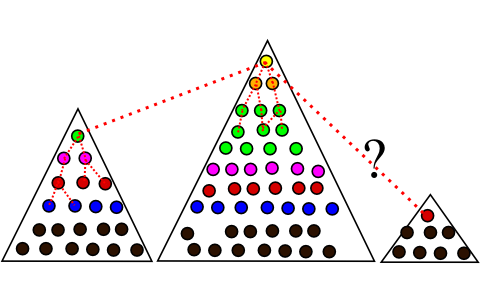
Top-level schemata can connect only to one or two lower-level schemata
According to the FIPP, the way to enlighten is to establish extremely high-level cognitive schemata in a certain field (sport, science, art &c.), which can later connect with the top-schemata of other pyramids through deduction. Thus, all the schemata of the person will be integrated in one schema, the top-schema.
In order to make this possible, the favored schema cannot be many levels higher than the surrounding e.g. second highest schema. The reason: that is although through deduction we can also make schemata at several lower levels, very large gaps cannot be bridged through deduction. As an instance, let us assume that Boris Becker knows http://en.wikipedia.org/wiki/Boris_Becker everything about tennis, and within tennis he has a schema, which would explain all the connections. But if he is only on the level of addition and cannot understand a multiplication, then he will have difficulties in connecting his tennis schema with his incomplete knowledge of mathematics.
Advertisement
This article, and many others, is now available in print.
The book, 'Self-expansion', contains a generalized version of FIPP not available on psy2.org
4. How do we reach enlightenment?
From the a general viewpoint, the way to enlightenment does not differ from normal life in that schemata are also established one after another, and so increase the height of our pyramids. The difference lies not in the nature of the process, but in its intensity, which depends upon:
- a question of talent
- the choice of the method
4.1 Talent and enlightenment
Perhaps it is not surprising, though rather undemocratic, that enlightenment can not be attained by everyone. To be able to establish a top-level schema, many schemata must be established beneath it. How many, it depends, how much information is found on the basic level and has to be integrated (cf. a hidden village, or a city’s wealth of information, or a caveman’s and a 20th century man’s knowledge).
The question is at what speed these various schemata can be established. It seems obvious to assume that, if someone is talented in a particular field, he can build the pyramid of that field more quickly. This matches the observation that talented children learn the basic-level schemata of the field they later become extremely talented at, much more quickly; Mozart leared the piano and began to compose at a much younger age than did his contemporaries with only general musical talent. Moreover, the greater the frequency of establishing new schemata, so the increasing frequency of Self-expansion. Engaging in a particular field enriches a child with positive feedback. In the meantime, this phenomenon also serves as a selective function, both in the choice of profession and of talented children. Those who do not have a genuine sense of achievement (Self-expansion) in certain fields will, sooner or later, give these up to benefit from what he is good at. Perhaps it sounds unscientific to base this on the presumption that we are born with different brains. However, we shall expand upon this later.
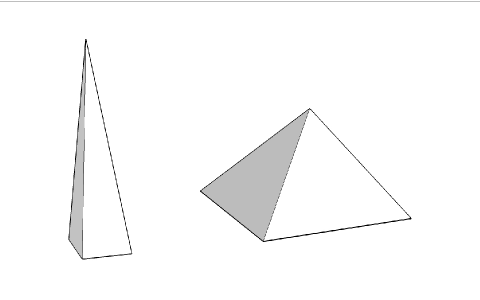
Some progress fast in a field, others double-check everything
Within a personality, the degree of risk-taking and motivation for success or, indeed, sensation seeking, affect the speed of acceptance of newly-born schemata. Some people are satisfied with a mere intuition of setting out on the right way, and take one step forward. Others (using deduction) check two or three times if the new schema covers the reality well enough. Checking is time-consuming, although it provides greater safety. The more schema there are, the safer the basis to be able to step up onto a higher level.
The pace of acceptance can be compensated with work, and talent with diligence. So, it is possible that someone establishes the new schemata at a slower pace, but if more time is spent upon it, then there is a chance to improve his performance.
4.2 What type of method leads to enlightenment?
This question sounds easy, but it would be pretentious to answer it in just a few words. A simple recipe can not be described, as each and every person has their own way of shaping their top-level schema. As by now mostly those became enlightened who reached a very high level in a special field it seems to be kind of criteria to reach enlightenment by becoming one of the bests of a particular field. However, it is also certain that it is not enough to be good in just one field, as we cannot then integrate everything. To achieve enlightenment, sooner or later, we have to connect the field we have mastered with the other fields of life, as the definition of enlightenment is that nothing can remain unintegrated.
It is also characteristic of the search method that:
- it has to cope with the frequent Self-narrowing – occasionally of a severe nature – that is a natural pre-requisite of often restructuring of the schemata and
- it has to deal with nobody being able to assure you that your efforts will lead to success (enlightenment), so continual uncertainty will accompany that effort. In sport, this appears in a spectacular and concentrated form: there are many professional cyclists in each country, but only a few from a country will participate at the Olimpic Games ( meaning that entered the club of the very bests of its field). The uncertainty of whether there is a chance of becoming one of the bests, and whether it is worth putting so much efforts into training, can only be overcome with serious coping strategies. Here, the rôle of the personality again arises: not only in choosing the tempo, but also in providing diligence, persistence, bearing and Self-narrowing. All these are matters in which the personality has an important rôle in connection with attaining enlightenment. That is why it is not incidental that people who want enlightenment do not care only about creating schemata, but previously – or concurrently – they prepare their personalities for resisting difficulties until reaching enlightenment, no matter how long that might take.
It is important to raise the following in connection with enlightenment: that an enlightened person will not know the answer to everything. His knowledge will not be immense and limitless. Rather, he will be aware of life, human motivation and behavior, and his own principal connections. He will have a deep understanding of the regulation of the universe. It is similar when, in understanding the concept of gravity, we do not only understand why the apple falls on our head, or why the planets move as they do, but perhaps also why there is attraction between people. That he realizes that two people can look for each others proximity, that there are certain persons – Royalty, “celebrities” – around whom others circle.
Advertisement
This article, and many others, is now available in print.
The book, 'Self-expansion', contains a generalized version of FIPP not available on psy2.org